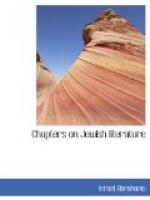On the intellectual side, therefore, Karaism was a powerful though ephemeral movement. In several branches of science and philology the Karaites made real additions to contemporary knowledge. But the main service of Karaism was indirect. The Rabbinite Jews, who represented the mass of the people, had been on the way to a scientific and philosophical development of their own before the rise of Karaism. The necessity of fighting Karaism with its own weapons gave a strong impetus to the new movement in Rabbinism, and some of the best work of Saadiah was inspired by Karaitic opposition. Before, however, we turn to the career of Saadiah, we must consider another literary movement, which coincided in date with the rise of Karaism, but was entirely independent of it.
BIBLIOGRAPHY
KARAITES.
Graetz.—III, 5 (on Troki, ibid.,
IV, 18, end. M. Mocatta,
Faith Strengthened, London, 1851).
Steinschneider.—Jewish Literature, p. 115 seq.
W. Bacher.—Qirqisani the Qaraite, and
his Work on Jewish Sects,
J.Q.R., VII, p. 687.
—— Jehuda Hadassi’s Eshkol
Hakkofer, J.Q.R., VIII,
p. 431.
S. Poznanski.—Karaite Miscellanies,
J.Q.R., VIII,
p. 681.
CHAPTER VII
THE NEW-HEBREW PIYUT
Kalirian and Spanish Piyutim (Poems).—Jannai.—Kalir.
Arabic to a large extent replaced Hebrew as the literary language of the Jews, but Hebrew continued the language of prayer. As a mere literary form, Rabbinic Hebrew retained a strong hold on the Jews; as a vehicle of devotional feeling, Hebrew reigned supreme. The earliest additions to the fixed liturgy of the Synagogue were prose-poems. They were “Occasional Prayers” composed by the precentor for a special occasion. An appropriate melody or chant accompanied the new hymn, and if the poem and melody met the popular taste, both won a permanent place in the local liturgy. The hymns were unrhymed and unmetrical, but they may have been written in the form of alphabetical acrostics, such as appear in the 119th and a few other Psalms.
It is not impossible that metre and rhyme grew naturally from the Biblical Hebrew. Rhyme is unknown in the Bible, but the assonances which occur may easily run into rhymes. Musical form is certainly present in Hebrew poetry, though strict metres are foreign to it. As an historical fact, however, Hebrew rhymed verse can be traced on the one side to Syriac, on the other to Arabic influences. In the latter case the influence was external only. Early Arabic poetry treats of war and love, but the first Jewish rhymsters sang of peace and duty. The Arab wrote for the camp, the Jew for the synagogue.




